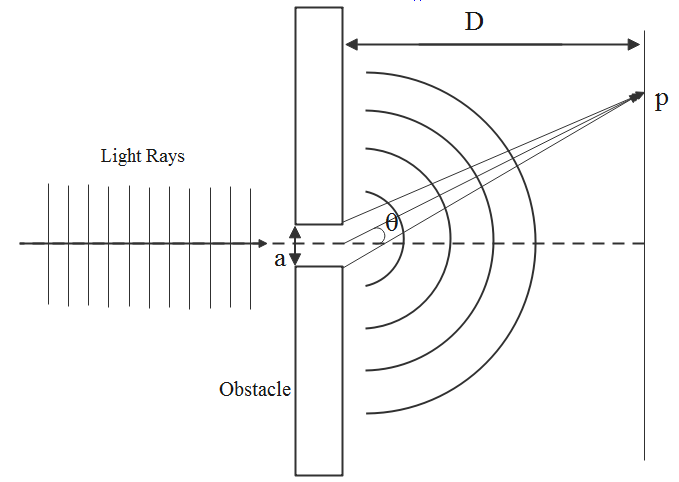
What is diffraction of light? Obtain condition for the bright and dark fringes in diffraction pattern due to a single narrow slit illuminated by a monochromatic source of light.
Answer
410.4k+ views
Hint: When attempting questions based on diffraction, keep in mind the concepts regarding diffraction like what causes it , what are the various conditions required for it to happen, what are the phenomena that happen when light travels in air and when it comes in contact with obstacles.
Complete step by step solution:
When light travels in air, it encounters various phenomena like interference, refraction, reflection and diffraction. When the light comes in contact with an obstacle, diffraction of light takes place. When light passes through a small opening, comparable in size to the wavelength
When monochromatic light is made on a single slit, we get a diffraction pattern on a screen placed behind the slit. The diffraction pattern contains bright and dark bands , also called bright and dark fringes, and the intensity of the central band is maximum and goes on decreasing on both sides.
In the single-slit diffraction experiment, we can observe the bending phenomenon of light or diffraction that causes light from a coherent source to interfere with itself and produce a distinctive pattern on the screen called the diffraction pattern. Diffraction is evident when the sources are small enough that they are relatively the size of the wavelength of light. For large slits, the spreading out is small and generally unnoticeable.
For easier calculation let us assume the slit width

Identify the angular position of any point on the screen by
Keep in mind this calculation will only be valid if
Consider any number of ray pairings starting from a distance
For a dark fringe, the path difference must cause destructive interference, the path difference must be out of phase by
Note: Young’s double slit experiment gave definitive proof of the wave character of light. An interference pattern is obtained by the superposition of light from two slits. There is constructive interference and destructive interference occurring in the experiment.
Complete step by step solution:
When light travels in air, it encounters various phenomena like interference, refraction, reflection and diffraction. When the light comes in contact with an obstacle, diffraction of light takes place. When light passes through a small opening, comparable in size to the wavelength
When monochromatic light is made on a single slit, we get a diffraction pattern on a screen placed behind the slit. The diffraction pattern contains bright and dark bands , also called bright and dark fringes, and the intensity of the central band is maximum and goes on decreasing on both sides.
In the single-slit diffraction experiment, we can observe the bending phenomenon of light or diffraction that causes light from a coherent source to interfere with itself and produce a distinctive pattern on the screen called the diffraction pattern. Diffraction is evident when the sources are small enough that they are relatively the size of the wavelength of light. For large slits, the spreading out is small and generally unnoticeable.
For easier calculation let us assume the slit width

Identify the angular position of any point on the screen by
Keep in mind this calculation will only be valid if
Consider any number of ray pairings starting from a distance
For a dark fringe, the path difference must cause destructive interference, the path difference must be out of phase by
Note: Young’s double slit experiment gave definitive proof of the wave character of light. An interference pattern is obtained by the superposition of light from two slits. There is constructive interference and destructive interference occurring in the experiment.
Recently Updated Pages
Master Class 9 General Knowledge: Engaging Questions & Answers for Success

Master Class 9 English: Engaging Questions & Answers for Success

Master Class 9 Science: Engaging Questions & Answers for Success

Master Class 9 Social Science: Engaging Questions & Answers for Success

Master Class 9 Maths: Engaging Questions & Answers for Success

Class 9 Question and Answer - Your Ultimate Solutions Guide

Trending doubts
Give 10 examples of unisexual and bisexual flowers

Draw a labelled sketch of the human eye class 12 physics CBSE

Differentiate between homogeneous and heterogeneous class 12 chemistry CBSE

Differentiate between insitu conservation and exsitu class 12 biology CBSE

What are the major means of transport Explain each class 12 social science CBSE

Why is the cell called the structural and functional class 12 biology CBSE




